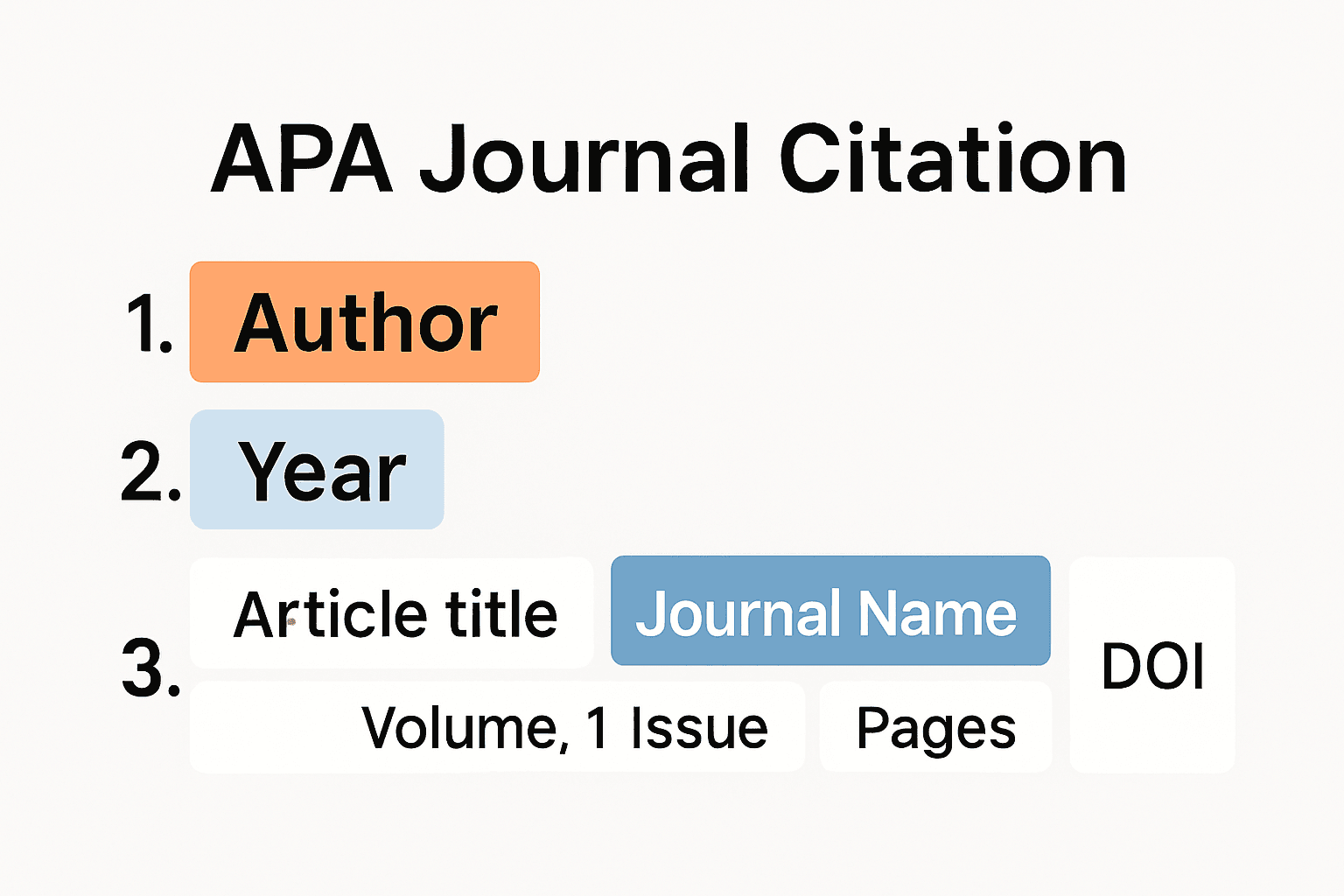Blog
Learning Materials
Hoe artikelen uit tijdschriften in APA-stijl te citeren in 2025
Updated: July 9, 2025

APA-citaties voor academische tijdschriften kunnen vervelend en overweldigend lijken, vooral met constante updates van de officiële richtlijnen. Hier is een twist. Meer dan 70 procent van de studenten maakt elke semester fouten in APA-referenties, en velen realiseren zich dit nooit. De echte schok is dat de meeste fouten eenvoudig en gemakkelijk te corrigeren zijn als je een paar insidertrucs kent, waardoor correcte citaties minder stressvol zijn dan je denkt.
Inhoudsopgave
- Basisprincipes van APA-citatie voor academische tijdschriften Dockerfile README.md email-templates i18n-config.ts i18nConfig.ts next-sitemap-samwell.config.js next-sitemap-semihuman.config.js next.config.js node_modules package-lock.json package.json process_content.js public scripts src svgr.d.ts translations tsconfig.json Kerncomponenten van tijdschriftartikelcitaten Dockerfile README.md email-templates i18n-config.ts i18nConfig.ts next-sitemap-samwell.config.js next-sitemap-semihuman.config.js next.config.js node_modules package-lock.json package.json process_content.js public scripts src svgr.d.ts translations tsconfig.json Specifieke citatie-elementen formatteren
- Stapsgewijze handleiding voor het citeren van tijdschriftartikelen Dockerfile README.md email-templates i18n-config.ts i18nConfig.ts next-sitemap-samwell.config.js next-sitemap-semihuman.config.js next.config.js node_modules package-lock.json package.json process_content.js public scripts src svgr.d.ts translations tsconfig.json Essentiële citatie-informatie verzamelen Dockerfile README.md email-templates i18n-config.ts i18nConfig.ts next-sitemap-samwell.config.js next-sitemap-semihuman.config.js next.config.js node_modules package-lock.json package.json process_content.js public scripts src svgr.d.ts translations tsconfig.json De referentie-invoer construeren
- Veelvoorkomende APA-citatiefouten om te vermijden Dockerfile README.md email-templates i18n-config.ts i18nConfig.ts next-sitemap-samwell.config.js next-sitemap-semihuman.config.js next.config.js node_modules package-lock.json package.json process_content.js public scripts src svgr.d.ts translations tsconfig.json Formatteer- en structurele fouten Dockerfile README.md email-templates i18n-config.ts i18nConfig.ts next-sitemap-samwell.config.js next-sitemap-semihuman.config.js next.config.js node_modules package-lock.json package.json process_content.js public scripts src svgr.d.ts translations tsconfig.json Uitdagingen bij het citeren van digitale bronnen
- Handige tools voor APA-tijdschriftcitaten Dockerfile README.md email-templates i18n-config.ts i18nConfig.ts next-sitemap-samwell.config.js next-sitemap-semihuman.config.js next.config.js node_modules package-lock.json package.json process_content.js public scripts src svgr.d.ts translations tsconfig.json Referentiebeheersoftware Dockerfile README.md email-templates i18n-config.ts i18nConfig.ts next-sitemap-samwell.config.js next-sitemap-semihuman.config.js next.config.js node_modules package-lock.json package.json process_content.js public scripts src svgr.d.ts translations tsconfig.json Online citatiegeneratoren Dockerfile README.md email-templates i18n-config.ts i18nConfig.ts next-sitemap-samwell.config.js next-sitemap-semihuman.config.js next.config.js node_modules package-lock.json package.json process_content.js public scripts src svgr.d.ts translations tsconfig.json Browser- en tekstverwerkerextensies
Korte Samenvatting
| Belangrijkste punten | Uitleg |
|---|---|
| Kerncomponenten van APA-citaties | Een volledige APA-citatie voor tijdschriftartikelen omvat de achternaam van de auteur, initialen, publicatiejaar, artikelnaam, tijdschriftnaam, volumenummer, uitgavenummer en paginabereik of DOI. |
| Citatie-informatie verzamelen | Voordat je citaties maakt, verzamel je essentiële elementen zoals auteursnamen, publicatiejaar en artikel- of tijdschriftgegevens om fouten te voorkomen. |
| Veelvoorkomende citatiefouten | Vermijd veelvoorkomende valkuilen zoals onjuiste titelcapitalisatie en inconsistente opmaak tussen in-tekst citaties en referentielijsten om academische integriteit te waarborgen. |
| Gebruik van citatietools | Maak gebruik van referentiebeheersoftware, online citatiegeneratoren en browserextensies om het citatieproces te stroomlijnen en de opmaaknauwkeurigheid te waarborgen. |
Basisprincipes van APA-citatie voor academische tijdschriften
Citaties van academische tijdschriften in APA-formaat vereisen precisie en aandacht voor specifieke details die zorgen voor correcte academische erkenning en intellectuele transparantie. Het begrijpen van deze fundamentele principes helpt onderzoekers hun bronnen nauwkeurig en professioneel te communiceren.
Kerncomponenten van tijdschriftartikelcitaten
APA-citatie voor academische tijdschriften omvat verschillende kritieke elementen die een gestandaardiseerde referentie creëren. In de kern omvat een volledige tijdschriftartikelcitatie de achternaam van de auteur, initialen, publicatiejaar, artikelnaam, tijdschriftnaam, volumenummer, uitgavenummer en paginabereik of digitale objectidentificatie (DOI).

De meest recente APA 7e editie introduceerde verschillende subtiele veranderingen die onderzoekers moeten begrijpen. Bijvoorbeeld, leer meer over moderne citatietechnieken om ervoor te zorgen dat je referenties voldoen aan de huidige academische normen. Auteurs moeten nu de DOI als een hyperlink opnemen wanneer beschikbaar, wat een blijvende manier biedt om de originele bron te lokaliseren.
Specifieke citatie-elementen formatteren
Bij het citeren van tijdschriftartikelen gelden specifieke opmaakregels. Volgens onderzoek van Monash University vereisen artikelen met meerdere auteurs zorgvuldige aandacht. Voor publicaties met 21 of meer auteurs moeten onderzoekers de eerste 19 namen vermelden, een ellips invoegen en vervolgens de naam van de laatste auteur vermelden. Deze aanpak behoudt uitgebreide toeschrijving terwijl te lange referenties worden voorkomen.
Digitale publicaties hebben unieke overwegingen. Bij het verwijzen naar een artikel met een artikelnummer in plaats van traditionele paginanummers, moeten onderzoekers het woord Artikel opnemen, gevolgd door het specifieke artikelnummer. Voor online publicaties in opkomst moet de citatie Advance online publication aangeven en de DOI of URL bevatten.
Professionele onderzoekers erkennen dat nauwkeurige citaties meer zijn dan technische vereisten. Ze vertegenwoordigen intellectuele eerlijkheid, waardoor lezers de oorsprong van ideeën kunnen traceren, onderzoeksclaims kunnen valideren en kunnen deelnemen aan het bredere academische gesprek. Door deze basisprincipes van citatie te beheersen, tonen wetenschappers hun nauwkeurigheid en respect voor het collectieve kennisopbouwproces in hun respectieve vakgebieden.
Nauwkeurige APA-citaties dienen meerdere doelen: ze bieden geloofwaardigheid aan onderzoek, maken kennis traceerbaar en geven de oorspronkelijke auteurs de juiste erkenning. Het begrijpen van deze fundamentele principes zorgt ervoor dat je academisch schrijven voldoet aan de hoogste normen van wetenschappelijke communicatie.
Stapsgewijze handleiding voor het citeren van tijdschriftartikelen
Het citeren van academische tijdschriftartikelen vereist een systematische aanpak die nauwkeurigheid en naleving van APA-richtlijnen waarborgt. Deze uitgebreide handleiding leidt je door het precieze proces van het maken van een professionele citatie die voldoet aan wetenschappelijke normen.
Essentiële citatie-informatie verzamelen
Voordat je begint met je citatie, verzamel je alle cruciale informatie van het tijdschriftartikel. Volgens de citatiegids van Simon Fraser University moet je de volgende belangrijke elementen verzamelen:
- Volledige naam van de auteur(s)
- Publicatiejaar
- Volledige artikelnaam
- Volledige tijdschriftnaam
- Volumenummer
- Uitgavenummer (indien van toepassing)
- Paginabereik of artikelnummer
- Digitale Object Identificatie (DOI) of URL
Professionele onderzoekers begrijpen dat zorgvuldige voorbereiding citatiefouten voorkomt. Verken geavanceerde citatietechnieken om je academische schrijfproces te stroomlijnen en precisie te waarborgen.
De referentie-invoer construeren
De APA 7e editie biedt specifieke opmaakrichtlijnen voor het maken van referentie-invoeren. Volgens de referentiegids van Victoria University volgt het standaardformaat deze structuur:
Auteur Achternaam, Voorletter. (Jaar van Publicatie). Artikelnaam. Tijdschriftnaam, Volumenummer(Uitgavenummer), Paginabereik. https://doi.org/xxxxx
Voor digitale publicaties zonder traditionele paginanummers, neem het artikelnummer op voorafgegaan door het woord Artikel. Wanneer een online publicatie in opkomst geen volledige publicatie-informatie heeft, gebruik Advance online publication en neem de DOI of URL op.
Belangrijke overwegingen voor verschillende scenarios zijn onder andere:
- Artikelen van een enkele auteur
- Publicaties van meerdere auteurs
- Alleen online tijdschriften
- Artikelen met digitale objectidentificaties
Onderzoekers moeten zorgvuldig letten op opmaakdetails. Cursiveer de tijdschriftnaam en het volumenummer, gebruik zinshoofdletters voor de artikelnaam en zorg voor consistente interpunctie in de hele referentie.
Het citatieproces gaat verder dan louter technische naleving. Het vertegenwoordigt een cruciaal onderdeel van academische integriteit, waardoor lezers een duidelijk pad krijgen om het originele onderzoek te verifiëren en te verkennen. Door deze citatietechnieken te beheersen, toon je wetenschappelijke nauwkeurigheid en respect voor intellectuele bijdragen in academische disciplines.
Om je snel inzicht te geven in de variaties in APA-citatieopmaak voor verschillende soorten tijdschriftartikelen, is hier een samenvattingstabel die de belangrijkste verschillen en vereiste elementen in elk scenario benadrukt:
| Scenario | Vereiste Elementen | Opmerkelijke Opmaakregels |
|---|---|---|
| Artikel van een enkele auteur | Naam van de auteur, jaar, titel, tijdschriftnaam, volume, (uitgave), paginas of DOI | Cursiveer tijdschriftnaam & volume, zinshoofdletters voor titel |
| Meerdere auteurs ( | ||
| <21) | All authors' names, year, title, journal name, volume, (issue), pages or DOI | List all authors, use ampersand before last name |
| Multiple Authors (21+) | First 19 authors, ellipsis (...), last author, year, title, journal, volume, (issue) | Insert ellipsis after 19th author, list last author only |
| Article with Article Number | Author(s), year, title, journal name, volume, (issue), Article [number], DOI | Use "Article" before number instead of page range |
| Advance Online Publication | Author(s), year, title, journal name, (if available), Advance online publication, DOI | Note "Advance online publication"; include DOI or URL |
Common APA Citation Mistakes to Avoid
Academic writing demands precision, and APA citations are no exception. Researchers frequently encounter pitfalls that can compromise the credibility of their scholarly work. Understanding and avoiding these common errors is crucial for maintaining academic integrity and professional standards.
Formatting and Structural Errors
One of the most prevalent citation mistakes involves improper formatting and structural inconsistencies. According to Alvernia University's citation guide, researchers often make critical errors in title capitalization. Learn more about precise citation techniques to ensure your references meet the highest academic standards.
In APA 7th edition, only the first word of the title, the first word after a colon, and proper nouns should be capitalized. Many researchers mistakenly capitalize every word, which directly violates APA guidelines. For example, the title "The impact of climate change on marine ecosystems" should not have every word capitalized.
Another frequent mistake involves inconsistent formatting between in-text citations and the reference list. According to Purdue Global Writing Center, researchers must ensure that every in-text citation precisely matches its corresponding reference list entry, with identical author names and publication years.
To help you avoid the most common APA citation mistakes, the following table summarizes key errors and the best practices to correct them:
| Common Mistake | Explanation/Example | Best Practice |
|---|---|---|
| Over-capitalizing Article Titles | Capitalizing Every Word in the Title (e.g., "Climate Change Impacts") | Use sentence case; only the first word & proper nouns are capitalized |
| Inconsistent In-text vs. Reference List | Author names/dates differ between text and list | Double-check author names and years for consistency |
| Missing DOI or URL for Digital Sources | Omitting required DOI of an online article | Always include DOI as hyperlink if available |
| Mishandling Multiple Author Citations | Listing all authors for articles with 21+ authors | List first 19, then ellipsis, then final author |
| Not Noting Advance Online Publication | Forgetting to add "Advance online publication" for pre-publication articles | Add "Advance online publication" and the DOI/URL |
Digital Source Citation Challenges

Digital publications present unique citation challenges that often trip up even experienced researchers. The most critical error involves mishandling Digital Object Identifiers (DOIs). As recommended by academic citation experts, when a DOI is available, it must be included in the reference entry. For online sources without a DOI, researchers should provide the publisher's URL.
Multiple-author publications require careful attention. When a journal article has more than 20 authors, researchers must list the first 19 authors, use an ellipsis, and then list the final author's name. This approach maintains comprehensive attribution while preventing excessively long references.
Advance online publications demand special notation. Citations for these sources should include "Advance online publication" and the specific DOI or URL. Many researchers overlook these nuanced requirements, potentially compromising the accuracy of their citations.
Professional researchers recognize that citation errors are more than mere technical mistakes. They represent potential breaches of academic integrity. Each citation serves as a critical link in the scholarly conversation, allowing readers to trace the origins of ideas, validate research claims, and engage with the broader academic discourse.
By understanding and avoiding these common citation mistakes, researchers demonstrate their commitment to scholarly precision. Accurate citations are not just about following rules they are about respecting intellectual contributions and maintaining the highest standards of academic communication. Careful attention to detail ensures that your research stands up to the most rigorous academic scrutiny.
Useful Tools for APA Journal Citations
Navigating the complex world of academic citations requires sophisticated tools that streamline the research and referencing process. Modern researchers have access to powerful digital solutions that simplify APA journal citations, ensuring accuracy and saving valuable time.
Reference Management Software
Reference management software has revolutionized academic writing and citation processes. Explore advanced citation techniques to maximize your research efficiency. According to Wikipedia's technology overview, tools like Zotero offer comprehensive citation management capabilities.
Key reference management tools include:
- Zotero: A free, open-source reference management tool that integrates seamlessly with web browsers. It allows researchers to collect, organize, and cite research materials automatically.
- Mendeley: An advanced reference manager that combines citation management with academic networking features.
- JabRef: An open-source citation software supporting multiple research databases and citation formats.
To help compare the top reference management tools mentioned, the following table summarizes their core features and strengths:
| Tool | Cost | Notable Features | Integration |
|---|---|---|---|
| Zotero | Free | Open-source, browser integration, automatic citation | Web browsers, Word, Google Docs |
| Mendeley | Free* | Citation management, academic networking | Word, PDF annotation |
| JabRef | Free | Open-source, BibTeX/LaTeX support | Research databases |
*Note: Mendeley offers additional paid features.
Online Citation Generators
Online citation generators provide quick and reliable solutions for researchers struggling with complex APA formatting requirements. These web-based tools automatically generate correctly formatted citations by parsing article information. Researchers can simply input article details, and the generator produces perfectly structured references.
Top online citation generators offer features like:
- Instant APA 7th edition formatting
- Support for multiple publication types
- Direct integration with research databases
- Export options for various document formats
Browser and Word Processor Extensions
Modern citation tools extend beyond standalone software. Browser extensions and word processor plugins enable researchers to capture citation information directly from academic websites and insert references with minimal manual intervention.
These extensions typically provide:
- One-click citation capture
- Automatic bibliography generation
- Seamless integration with popular writing platforms
- Real-time formatting checks
Researchers must select tools that align with their specific workflow and institutional requirements. While these technologies significantly reduce citation-related stress, they are not infallible. Always double-check generated citations against official APA guidelines to ensure absolute accuracy.
The landscape of citation tools continues to evolve, with artificial intelligence and machine learning promising even more sophisticated solutions in the coming years. By leveraging these advanced technologies, researchers can focus more on their intellectual contributions and less on technical formatting challenges.
Frequently Asked Questions
What are the core components of an APA citation for academic journal articles?
A complete APA citation includes the author's last name, initials, publication year, article title, journal name, volume number, issue number, and page range or DOI.
How do I format multiple authors in an APA citation?
For articles with 21 or more authors, list the first 19 authors, insert an ellipsis, and then include the last author's name. For works with fewer than 21 authors, list all authors' names in the citation.
What should I do if my journal article doesn't have traditional page numbers?
If an article has an article number instead of page numbers, include the word "Article" followed by the article number in the citation. If it's an advance online publication, note it as "Advance online publication" and include the DOI or URL.
What common mistakes should I avoid when formatting APA citations?
Avoid over-capitalizing titles, ensuring consistent formatting between in-text citations and the reference list, and always including a DOI for digital sources when available.
Eliminate APA Stress: Let Samwell.ai Perfect Your Citations
Struggling with APA journal citations can make even the most confident writers feel overwhelmed. If you worry about small mistakes costing you points, missed DOIs, or confusing author formats, you are not alone. The article above highlights how tricky it is to keep up with evolving citation rules and how common errors in formatting and digital references can quickly derail your hard work.

Why keep risking errors when a smarter solution is available right now? Samwell.ai is designed to remove citation guesswork entirely. Our advanced platform helps you generate, review, and perfect APA references in seconds. Let our Semihuman.ai technology ensure every reference is accurate and original so you can focus on your research instead of citation formatting. Ready to take control and avoid common citation pitfalls discussed in this guide? Start building error-free references with Samwell.ai or discover more ways we support academic excellence in our APA citation research paper guide.
Recommended
Generate essays with Samwell.ai
Whether you’re a publisher, professor, journalist, or student, let us tailor a plan just for you.Meest gelezen artikelen

Gids voor het succesvol schrijven van opdrachten
Professionele tips voor het schrijven van essays: van het formuleren van argumenten tot het effectief opbouwen van de structuur van je essay.

Schrijfvaardigheden: Beheersing van schrijfstrategieën
Verrijk het schrijven van je essay met advies van experts, inclusief analyse, het formuleren van een these en effectieve structurering.

Hoe schrijf je een kritisch reflectief essay: Tips van experts
Experttips: Hoe schrijf je een kritisch reflectief essay. Leer hoe je het structureert, een onderwerp kiest en bewijsmateriaal effectief gebruikt.

Hoe schrijf je een effectieve inleiding: een stap-voor-stap gids
Beheers de kunst van het creëren van boeiende introducties met onze gids. Maak interessante starts die een onuitwisbare indruk achterlaten.
